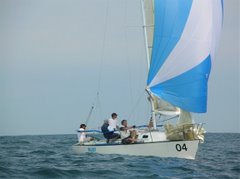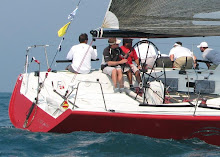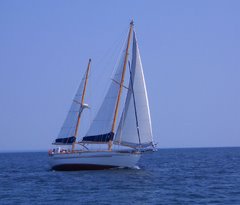
2006 TP52 Globals - March 2006
So I will try to blast out three posts this week before I head for Palma Vela to set a baseline for my future writing. Today I will focus on the 2006 TP52 Globals and my experience sailing on the Gen 1 NM TP52, then later this week on Sardinia Cup and the Med focused B&C TP52s, and then a report with some general thoughts on this summer’s sailing.
Generation 1 Meets 2006
So to start with, Glory and the other generation 1 TP52s were designed specifically for the Transpac Race to
So the 2006 Globals started inauspiciously with us continuing to rig the boat and looking at our brand new Quantum sails on the way to the racecourse. What was a slow start gained momentum as we generally improved our gap to the top 3 boats in the inshore races from roughly 3 minutes behind to as little as 15 seconds by the end of the week. Overall I think that we could attribute a lot of that to getting use to the new modifications, improved boat-handling and a doing a better job of shifting gears downwind (between a more aggressive reaching mode or digging deep).
Observation 1: While the 2003 Glory was fast upwind/downwind with her new facelift, we continued to suffer from reduced form stability uphill, and we gave away a lot power reaching to the newer designs which sported much wider transoms. Additionally, we were a much different boat when it came to weight of hull and bulb and internal ballast. During the 12 months that we sailed this boat, we affectionately called Glory “the cruise-liner” because of her especially stout build, and we were amazed to see how light (and few ring frames) many of new builds had just 2 years later (driven by the Med conditions/designs). Despite the extra weight in the hull we were quick enough around the track, and especially later in the regatta we were often able to hold our own inshore against the newer designs such as the 2005 Farrs. When the Nelson 52 was sold to a new owners in Australia, we felt that we had really spent a lot of time getting the most out of the boat and that the design changes were worth it - especially when she went on to nearly win her class in the Sydney Hobart as WotYot.
Observation 2: Crew work/systems at this level is very refined – Well no kidding, anyone would all expect this but having started from scratch with the 2003 systems, we saw exponential improvement as we changed or upgraded. When designed, the sail handling systems for the generation 1 boats were designed to use one pedestal to drive the primaries, with drive shafts above deck for extra headroom below. They were set up with two halyard winches, two primaries linked to a single pedestal, two mainsheet winches with a full 2:1 German Admiral's Cup dedicated winch mainsheet system and then a set of secondary winches for in-line changes and peels (which we removed in the refit). This is a decent all-around system, but short on horsepower when compared with the latest generation bots when jibing and in prestart maneuvers. As time went by this proved less then optimal for round the cans racing and If I was going to single out one change that made the boat easier to sail – it would have to be the overdrive gears on the primaries. When we started jibing Glory we were taking around 18 seconds from initiating the jibe, furling the staysail, jibing the pole (disconnect and running it back until it cleared the hoisted staysail) and then completing the jibe, and unfurling. Over the course of the Globals we reduced that time to 8-11 seconds simply by changing technique for moving the pole and use of overdrive gearing.
Even with multiple pedestals linked together, the maximum power (according to Harken) a human can generate is 200rpm. That equates to a winch line speed of 94m/min. With the first gear of 1:1, the line speed is still too slow to get these big asymmetric around efficiently – the overdrive kit accelerates the winch by 2.4 times (Gear Ratio of 1:2.4). Now the overdrive turns the winch in first gear (1:1) and in overdrive (1:2.4), 1 turn of the handle generates 2.4 turns of the winch drum. This equates to a line speed of 225m/min. This means that you have to move quick keep up with the grinders as the rope is spit from the winch on the jibes - this is now a must have for asymmetrical kites (even the GP42 are sprouting pedestals) to get the kite around at blazing speeds.
Additionally while many of the 2005/2006 boats had two pedestals we only had a single one – so getting the main across in jibes was painful. Key through the jibes, was for our trimmers to be top-handling the guys back in addition to use of the pedestal (which is less than efficient). While the grinders were pulling the kite around in overdrive, they were also trying to muscle the guy back and relying on the offside trimmer to be on a handle to keep from bogging down mid-jibe. The 2005 and newer systems, and the new system on Glory, are able to lock all the pedestals (4 grinders) together to bring across the main, pull the kite around and the pole back at the same time. Additionally the majority of the boats this year will be using a pedestal to drive the cabin top winch to hoist the kite halyard (aiding in speed and smoothness).
Side Note:
One aspect of the TP52 class is that it requires distance racing in major events. Now I have never been a fan of offshore/distances racing since most of my memories are of slogging upwind on paper-thin one-tonners, through the night, riding the rail in the bow position. However, the distance race at the Globals had to be one of the most fun experiences of my sailing career as we crossed the Gulf Stream twice and were rewarded with blasting back from the
Later this week – Racing the Med TP52s in



1 comment:
Feel free to do so, thanks for the appreciation
Post a Comment